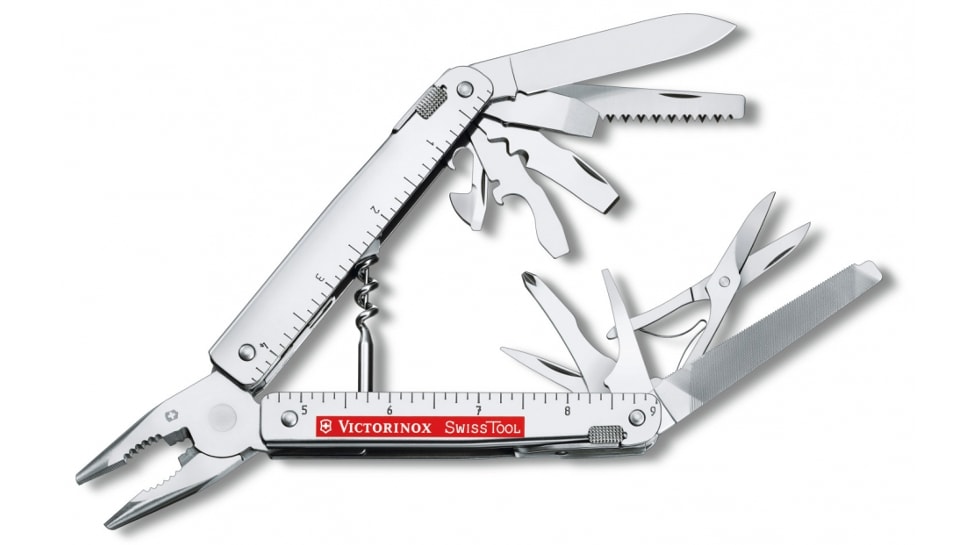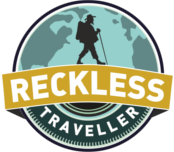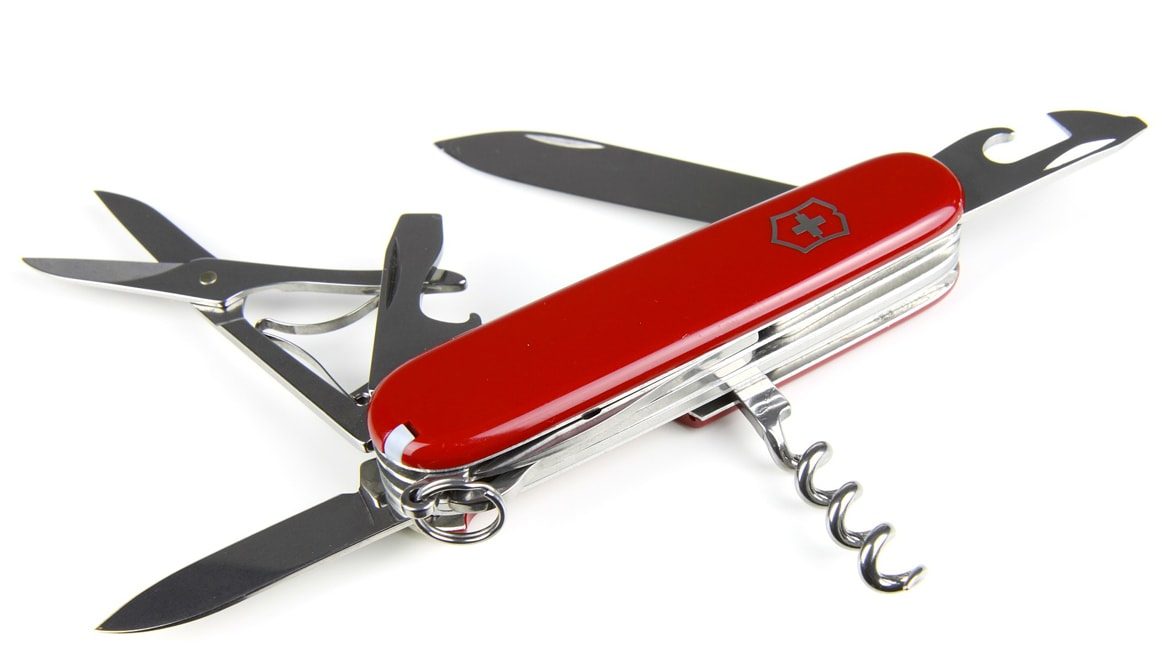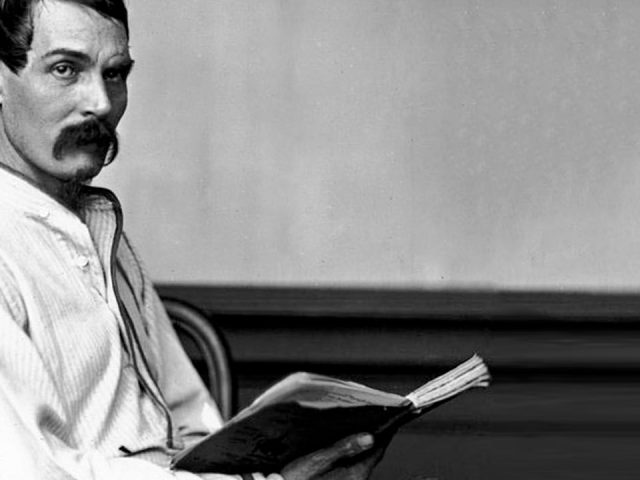Now here is a subject dear to my heart. My old Uncle Eric in Newfoundland always carried a knife with a red handle. He would use it mainly to ream his big pipe on which he constantly puffed. Ream-ream, tap-tap, puff-puff. I loved my old uncle and his sweet-smelling pipe-smoke.
One day, when I was about seven, I asked him, “Uncle Eric, what kind of a knife is that?” He looked up with a smile and answered, “Why, that’s my Swiss Army Knife, boy. Couldn’t do without it – it’s an old friend!” I could tell he was very fond of it, and happy I’d noticed it.
Well, I was fascinated – and by the time I hit my twenties, I figured I could afford to buy one, and did. In the intervening years I have continued to buy various Swiss Army tools. I’ve got a drawer-full – including a Swiss Army can opener and vegetable peeler. My very favorite, however – my constant companion – is my Swisstool, a splendid multi-tool from the same wizards that make the SAK. I carry it like a talisman. In fact, I feel rather naked without it, and can hardly walk straight, such is my dependence upon it.

The genuine SAK is produced by Victorinox, a knife manufacturer based in Ibach, in central Switzerland. They are made of top-quality components; blades, for example, are made of Swedish stainless steel from Sandvik. Victorinox is the largest manufacturer of pocket knives in the world, their automated process turns out more than 34,000 a day.
The SAK comes in many forms, but essentially it has at least one blade plus a variety of basic tools – screwdriver, saw, can opener and so on. Modern SAKs come with astonishing features like a flash drive, pen, flashlight cigarette lighter, and Bluetooth functionality. These guys aren’t resting on their laurels.
The handle is generally made of red plastic with a Swiss cross logo. The SAK has been called a “tiny classic of industrial design.” Moreover, this gem is guaranteed for the owner’s life. I once foolishly broke a blade harvesting an oyster, and they gave me a replacement knife, no questions asked, postpaid. The term “Swiss Army Knife” was coined by American soldiers who learned of it during WWII. Apparently, they preferred that name to the German term: “Offiziersmesser”.
SAK to the Rescue:
One of the things I like about travel is that there are always challenges that arise to test one’s coping skills, ingenuity and preparedness. One day I was travelling by beater taxi in Jordan, going from Amman to Petra. We were way out in the desert – many miles from water, phone or habitation – and the driver declared an emergency: the engine was overheating. A check under the hood disclosed the reason: a total loss of coolant. I pulled out my SAK and tightened a few clamps. Then, holding our collective breath, we poured all our drinking water into the radiator – and hoped for the best. The first aid worked well. The SAK saved the day.
 Some years later when travelling by camel in the Thar Desert in NW India, one of our amimals abruptly went lame. The camel-wallas conferred and discovered that one foot had a long thorn in it. I volunteered that I might be able to help, and pulled out my SAK. The wallahs smiled approvingly. I was able to extract the thorn without much fuss. We disinfected the foot with beer, and we were soon on our way over the dunes.
Some years later when travelling by camel in the Thar Desert in NW India, one of our amimals abruptly went lame. The camel-wallas conferred and discovered that one foot had a long thorn in it. I volunteered that I might be able to help, and pulled out my SAK. The wallahs smiled approvingly. I was able to extract the thorn without much fuss. We disinfected the foot with beer, and we were soon on our way over the dunes.
Another time, when travelling by dilapidated Mexican bus from Bakersfield to L.A., the engine quit. Of course, the bus had no tool kit, so I offered the driver my SAK to attempt a repair. After much huffing, puffing, cursing and skinned knuckles it dawned on us that what we actually needed was not a mere SAK, but another bus. It took four hours to get there.
The SAK story started in the late 1890s when a Swiss maker of surgical instruments named Karl Elsener got a patent for the “Officer’s and Sports Knife”. He then earned a contract to supply the knife to the Swiss Army; 130 years later, his company still holds the contract. Naturally, the knife’s design continues to evolve; it has become a trusted tool of outdoor enthusiasts around the world. The company collects interesting “Swiss Army Knife Stories” on its website.
In recognition of its excellence, the SAK is issued as standard equipment to NASA astronauts. Fixing a spaceship with an SAK…what an idea! Moreover, the Victorinox Swiss Champion model is included in the Permanent Design Collection of the New York Museum of Modern Art. It has also been carried to the summit of Mount Everest.

After 9/11, airline security tightened and the bottom fell out of Victorinox’s market. Sales collapsed 40%. Victorinox’s main competitor (Wenger SA) allowed itself to be annexed by Victorinox in 2005.
The upshot: if you want to take your knife with you when you fly, it must go into your checked baggage, which is a distinct pain.
I much prefer travelling with just a carry-on, so sometimes I send the SAK ahead by mail. Once, when I forgot to pack my knife in my checked bag and needed to go through security, I persuaded a Westjet agent to mail my knife home to me.
But whatever the cost or inconvenience, I go nowhere without my friend.
By carrying a SAK, and knowing how to use it, you can greatly increase your usefulness and independence – not to mention drawing admiring glances and comments. My wife, kids and grandkids have them. Every self-respecting adventure traveller simply must have one, and no mistake. If you don’t own a SAK, what on earth have you been doing? There’s really no time to lose… get one without delay! Accept no substitute…and just say no to “knock-offs”! But I’m starting to rant – sorry!






Facebook Comments